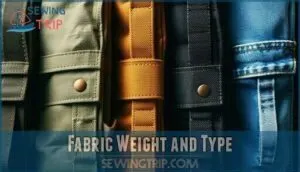This site is supported by our readers. We may earn a commission, at no cost to you, if you purchase through links.
 Learning how to sew a backpack transforms you from buyer to creator in just one weekend.
Learning how to sew a backpack transforms you from buyer to creator in just one weekend.
You’ll need sturdy canvas or ripstop nylon, a heavy-duty sewing machine, and basic hardware like buckles and zippers.
Start by cutting your main panels, side gussets, and bottom piece from a reliable pattern. Think of it like building a fabric box with straps—sounds simple, right?
The magic happens when you attach the shoulder straps and add those finishing touches that make it uniquely yours.
Sure, your first attempt might look like it wrestled with a bear, but the satisfaction of carrying your handmade creation beats any store-bought bag.
The secret lies in mastering a few key techniques that separate amateur attempts from professional-looking results.
Table Of Contents
Key Takeaways
- You’ll need the right materials and tools – Gather 1000 denier Cordura or ripstop nylon fabric, heavy-duty thread, webbing, buckles, zippers, and a sturdy sewing machine with a walking foot before you start cutting anything.
- Start with a solid pattern and prototype first – Create paper templates from your measurements, then test your design with cheap fabric to catch sizing and functionality issues before using expensive materials.
- Focus on reinforcing stress points during construction – Double-stitch all major seams, add extra fabric patches where straps attach, and use bartack stitching at high-wear areas to prevent your backpack from falling apart.
- Layer your assembly process systematically – Sew straps and pockets first, then assemble the main body panels, attach hardware like zippers and buckles, and finish with waterproof coatings for durability.
Sewing Backpack Basics
Before you start cutting fabric and threading your sewing machine, you’ll need to gather the right materials, tools, and fabrics that’ll turn your backpack dreams into reality.
Think of this as building your sewing toolkit, where choosing quality Cordura fabric and the right hardware makes the difference between a backpack that lasts for years and one that falls apart after a few camping trips.
Essential Materials
Creating your perfect backpack starts with gathering the right materials.
You’ll need quality fabrics, hardware, and padding to build something that lasts. Think of it as assembling your toolkit before tackling any project.
Here’s your essential shopping list:
- Fabric selection: 1000 Denier Cordura for durability, Ripstop Nylon for lightweight lining
- Nylon webbing: 1-inch and 2-inch widths for straps and reinforcement
- Hardware essentials: Buckle hardware, D-rings, zipper, and foam padding for comfort
Necessary Tools
Having your materials ready means nothing without the right sewing tools.
You’ll need a reliable sewing machine—preferably one with a walking foot for thick fabric.
Sharp fabric scissors are your best friend for clean cuts.
Don’t forget measuring devices like rulers and tape measures, plus marking tools such as fabric chalk.
Basic pins and pressing tools complete your toolkit.
Consider browsing options for a new sewing machine to upgrade your setup.
Fabric Selection
Choosing the right fabric makes or breaks your backpack project.
Cordura benefits include incredible durability and weather resistance, while ripstop nylon offers lightweight strength for linings.
Alternative fabrics like canvas work well for beginners using home machines.
Don’t forget mesh panels for breathability and foam padding for comfort—these backpack sewing materials transform your creation from basic to brilliant.
How to Sew Backpack
Now that you’ve gathered your materials and tools, it’s time to roll up your sleeves and start your backpack sewing tutorial.
Think of this DIY backpack pattern as building a sandwich – you’ll layer pieces systematically to create something amazing.
Your sew backpack beginners journey starts with understanding the construction flow:
- Start with straps and padding – These foundation pieces need attention first
- Assemble internal components – Laptop pockets and organizational features come next
- Connect main panels – Front, back, and side pieces form your backpack’s skeleton
- Add hardware and closures – Zippers, buckles, and rings bring functionality
- Finish with seam reinforcement – Double-stitch stress points for longevity
Focus on ergonomic design and weight distribution as you work.
Each backpack pattern requires patience, but the weatherproofing techniques and upcycling materials you’ll master make every stitch worthwhile.
Remember, even experienced sewers started somewhere!
Choosing Right Fabric
Your fabric choice makes or breaks your backpack project, so you’ll want something that won’t give up after a few trips to school or the hiking trail.
The right fabric is your backpack’s foundation—choose wisely, or watch your hard work fall apart at the seams.
Think of fabric like choosing a best friend for your backpack – you need something tough enough to handle your stuff but nice enough that you won’t get tired of looking at it every day.
Durability Considerations
Beyond pretty patterns, your fabric choice determines whether your backpack survives daily adventures or falls apart after a few uses.
Higher denier ratings mean stronger threads that resist tearing and wear.
| Durability Factor | Impact on Backpack Life |
|---|---|
| Seam Reinforcement | Prevents stress point failures |
| Material Abrasion | Resists daily wear and friction |
| Weather Resistance | Protects contents from elements |
Smart construction techniques like double-stitching and bartack reinforcement create bulletproof stress points that’ll outlast your college years.
Style and Functionality
Once you’ve got durability sorted, you’ll want to balance backpack aesthetics with practical features.
Think about your user preferences – will you rock a sleek look or go bold with patterns? Consider versatile use too.
That laptop pocket might clash with your hiking vibe, but hey, functionality wins. Smart backpack design means your ergonomic design supports both style and real-world backpack functionality needs.
Fabric Weight and Type
Fabric weight determines your backpack’s durability and performance.
Denier Explained: higher numbers mean thicker, stronger materials. For beginners, 400D fabric offers the sweet spot between weight and strength.
Consider also the backpack fabric weight when selecting materials.
Cordura vs Nylon shows Cordura wins for toughness, while Canvas Durability excels in natural options.
Denim Backpacks work great for casual use. Even Velvet Considerations matter for lightweight designs.
Creating Backpack Pattern
You’ll need to create a paper pattern that acts like a blueprint for your backpack, similar to how architects draw house plans before building.
Start by sketching your design on grid paper, then enlarge it to actual size with measurements for each piece, because even small errors here can turn your dream backpack into a wonky disaster.
Measuring and Designing
Start your backpack design process by sketching orthographic views from front, back, and side angles to capture every detail.
Create perspective sketches that reveal hidden components and functionality.
Consider design considerations like torso lengths and intended use when determining backpack dimensions.
Accurate pattern making begins with these detailed drawings – they’re your blueprint for success in the backpack design process.
Prototyping and Editing
Your backpack prototype becomes your testing ground where dreams meet reality.
Testing your pattern with scrap fabric saves expensive materials while revealing design flaws early.
Here’s your prototyping roadmap:
- Design Iteration – Cut test pieces from cheap fabric to check proportions and functionality
- Fit Adjustments – Try on your prototype to confirm comfortable strap placement and sizing
- Material Testing – Verify seam stress points can handle weight without tearing
- Feature Refinement – Test pocket placement and zipper functionality before committing to final materials
Smart prototyping prevents costly mistakes later.
Pattern Making Tips
Once you’ve tested your backpack prototype, it’s time to perfect your pattern making skills.
Always mark fabric grain direction on each piece – it prevents wonky seams later. Double-check symmetry accuracy by folding patterns in half.
Include generous seam allowance (at least half an inch) and label each piece clearly. When editing patterns after prototype testing, use different colored pens to track backpack pattern alterations, which helps in maintaining a clear record of prototype testing.
Cutting Fabric Pieces
Now that you’ve got your pattern ready, it’s time to transform those paper templates into actual fabric pieces—think of it as turning your blueprint into building materials.
You’ll need to measure twice and cut once, because unlike that time you accidentally cut your bangs too short, fabric mistakes can’t just grow back out.
This process requires careful attention to detail to avoid mistakes, and it’s essential to get it right, as fabric mistakes are irreversible.
Accurate Measurement Techniques
Your pattern’s ready, but measuring wrong can turn your dream backpack into a fabric nightmare.
Always double-check body measurements before pattern scaling.
Use a quality measuring tape and mark seam allowances clearly on each piece.
Check fabric grain direction and run symmetry checks on paired pieces.
These fabric measurements determine whether you’ll carry books or disappointment.
Using Rotary Cutter
Your rotary cutter is a game-changer for cutting fabric pieces with precision.
Hold it firmly at a 45-degree angle and roll smoothly in one direction. Replace dull blades regularly for pattern accuracy and clean cuts.
Use a cutting mat to protect surfaces and maintain blade sharpness. Practice rotary cutter safety by keeping fingers away from the blade path, ensuring clean cuts.
Cutting Complex Shapes
Complex backpack patterns with curves and corners demand extra attention to detail.
Use sharp fabric scissors for intricate cuts, following your template’s lines precisely.
Pay attention to fabric grain direction when cutting shaped pieces like curved shoulder straps or rounded pocket flaps.
Take your time with corner accuracy—rushing leads to wonky seams that’ll haunt your finished backpack forever, making extra attention crucial for a professional finish.
Sewing Backpack Panels
Now you’ll stitch your backpack panels together like you’re building a fabric sandwich, layering the outer shell, padding, and lining with precision.
This step transforms your cut pieces into the actual backpack structure, and while it might feel like juggling three different fabrics at once, the process becomes surprisingly straightforward once you get the hang of it, creating the actual backpack structure.
Assembling Outer Shell
Now that you’ve cut your fabric pieces, it’s time to bring them together. Panel Construction forms the backbone of your backpack – think of it like building a house where each wall needs to connect perfectly.
Here’s your assembly roadmap:
- Baste front and back panels together at side edges, leaving 3cm gaps below top edges
- Apply Edge Binding to all raw edges using binding tape for clean, professional finish
- Reinforce bottom seams with flat-fell stitching – your backpack’s foundation needs extra strength
- Create Seam Reinforcement at stress points using double-stitching or bartacking techniques
- Test-fit all pieces before final stitching – catching mistakes now saves headaches later
Attaching Lining and Pockets
With your outer shell complete, it’s time for lining a backpack and adding backpack functionality.
Pin your lining fabric right sides together with the shell, leaving a 4-inch opening for turning.
Sew pockets directly onto lining before attachment – reinforcing pocket reinforcement at stress points.
Install zipper integration carefully, ensuring smooth operation while maintaining clean lining seams throughout.
Sewing Straps and Handles
With your pockets secured, you’ll tackle sewing backpack straps next.
Cut webbing reinforcement strips and sandwich padding between fabric layers for ergonomic design.
Sew the top handle first, then work on shoulder straps using proper attachment methods.
Consider handle alternatives like padded grips.
When attaching back pieces, reinforce all strap attachments with extra stitching—your shoulders will thank you later, ensuring a secure and ergonomic design with proper attachment.
Adding Hardware and Details
Now you’ll transform your sewn panels into a fully functional backpack by attaching buckles, zippers, and D-rings that make everything work smoothly.
This step’s like giving your backpack its personality, where each piece of hardware serves a specific purpose and needs secure attachment to handle daily wear and tear, making it a crucial part of creating a functional and durable backpack with secure attachment.
Attaching Buckles and Rings
Properly securing your backpack hardware transforms a flimsy bag into a reliable companion. Start by positioning aluminum cam buckles and D-rings at stress points where straps meet the main body.
Many retailers offer various buckle options for different backpack needs.
- Buckle Placement: Thread webbing through quick release buckles, fold one inch, then sew with reinforcing X-pattern stitches
- Ring Types: Use metal D-rings for shoulder strap attachments, ensuring secure attachment points
- Stress Reinforcement: Double-stitch all webbing integration points for maximum durability
Adding Zippers and Closures
Now that you’ve secured your buckles and rings, it’s time to tackle zippers and closures.
Start by pinning your zipper tape with the slider positioned correctly. Fold the zipper tape under at both ends instead of cutting notches – this prevents teeth misalignment. Test your closure mechanism before final stitching to confirm smooth operation.
| Closure Type | Best Use | Difficulty Level |
|---|---|---|
| Standard Zipper | Main compartment access | Beginner |
| Magnetic Snaps | Quick-access pockets | Easy |
| Flap Closures | Weather protection | Intermediate |
| Drawstring Options | Cinch-top bags | Beginner |
| Double Zipper | Large openings | Advanced |
Reinforcing Stitches and Seams
Strengthen your backpack’s lifeline by doubling down on stress point reinforcement.
Bartacking methods work wonders at strap attachment points—think of them as your backpack’s insurance policy.
Increase stitch density around high-wear areas and use reinforcement materials like extra webbing.
These backpack construction techniques and seam finishing techniques transform flimsy into fortress-strong, ensuring your creation survives daily adventures with daily adventures.
Backpack Customization Options
You can transform your handmade backpack into something uniquely yours by mixing fabrics, adding extra pockets, or swapping standard straps for colorful webbing that matches your style.
Think of this step as the fun part where your backpack stops looking like everyone else’s and starts reflecting your personality, whether you’re going for subtle elegance or bold patterns that’ll make your friends ask where you bought it.
Choosing Colors and Fabrics
Your fabric choices set the stage for your backpack’s personality.
Color psychology plays a role – blues suggest trust while greens feel outdoorsy.
Mix seasonal colors with complementary prints for visual interest.
Texture contrast adds depth when pairing smooth ripstop with textured canvas.
Consider fabric combinations that reflect your style while maintaining durability, making smart backpack materials selection crucial to create a backpack that is uniquely yours.
Adding Pockets and Compartments
Now that you’ve chosen your fabric combo, it’s time to add the fun stuff – pockets and compartments that’ll make your backpack actually useful.
Smart pocket placement turns a basic bag into your personal command center, whether you need zippered security for valuables or hidden compartments for secret snacks.
Consider these pocket options for maximum functionality:
- Laptop pocket with padded foam lining and velcro closure for device protection
- Front pouches with elasticized pockets for water bottles and quick-grab items
- Zippered security compartments along side panels for keys and small electronics
- Modular attachments using D-rings and webbing for removable gear pouches.
When sewing pockets, remember that adding pockets to your backpack requires careful planning before you start cutting fabric.
Position your laptop pocket against the back panel for weight distribution, while front pocket placement should consider your reach and daily essentials.
Customizing Straps and Handles
After adding those handy compartments, let’s tackle the backbone of your backpack – literally. Your straps determine comfort during those long hauls, so choosing the right materials matters.
Consider reflective webbing for visibility or ergonomic padding for shoulder relief. Adjustable length mechanisms let you fine-tune fit, while handle reinforcement prevents tear-outs.
| Strap Feature | Standard Option | Custom Alternative |
|---|---|---|
| Material | Basic nylon webbing | Reflective webbing with padding |
| Width | 1-2 inch standard | Variable widths for comfort |
| Padding | Thin foam insert | Ergonomic padding systems |
| Hardware | Basic cam buckles | Strap cam adjusters with quick-release |
| Attachments | Simple loops | Reinforced D-ring connections |
Smart backpack strap design starts with understanding your carrying needs. Heavy loads demand wider straps with better padding distribution.
Alternative materials like padded mesh or memory foam transform basic webbing into comfort zones. When planning strap attachments, reinforce connection points with additional layers – your shoulders will thank you later.
Remember, backpack sewing isn’t just about function; it’s about creating gear that works as hard as you do.
Ensuring Backpack Durability
You’ll want your handmade backpack to survive years of adventures, not fall apart after the first camping trip like that store-bought bag you regret buying.
Smart reinforcement techniques and quality materials make the difference between a backpack that lasts decades and one that becomes expensive scrap fabric, utilizing smart reinforcement techniques.
Reinforcing Stress Points
After customizing your backpack’s features, you’ll want to bulletproof the areas that take the most beating. Think of stress points like your backpack’s joints – they need extra TLC to prevent embarrassing blowouts.
Here’s your reinforcement game plan:
- Seam Reinforcement – Double-stitch all major seams using bartack stitching
- Webbing Attachment – Add extra fabric patches where straps meet the body
- Rivet Placement – Install metal rivets at high-stress connection points
- Stress Distribution – Use wider fabric strips to spread load across larger areas
- Reinforced Backpack Bottom – Layer extra fabric or add protective panels underneath
Smart backpack construction means thinking like an engineer – distribute forces and strengthen weak spots before they become problems.
Using Waterproof Materials
Beyond strengthening weak points, selecting the right waterproof materials transforms your backpack into a weather-resistant champion.
Waterproof Cordura and laminate fabrics create an impenetrable barrier against moisture. You’ll need seam sealing tape for interior stitches and waterproof zippers to prevent leaks.
DWR coatings on regular fabrics offer budget-friendly protection. This waterproof backpack tutorial guarantees your gear stays bone-dry during adventures.
Applying Protective Coatings
Beyond waterproof materials, protective coatings add an extra shield against the elements.
Think of coatings as your backpack’s armor – they boost UV resistance and abrasion protection while extending coating durability.
Here’s your coating arsenal for backpack waterproofing:
- Waterproof sprays – Hold 6 inches away, apply two light coats
- Fabric sealants – Perfect for seam sealing vulnerable stitch holes
- Wax-based coatings – Rub in circular motions, heat-activate with hairdryer
- TPU treatments – Premium option for superior strength
- Silicone sprays – Tricky application but excellent water repellency
Your waterproof backpack tutorial isn’t complete without proper coating application.
Finishing Touches and Tips
Once you’ve sewn all the main pieces together, you’ll want to add those final details that transform your project from "homemade" to "wow, did you really make that yourself?"
These finishing touches, along with simple maintenance tips, will keep your new backpack looking sharp and functioning smoothly for years to come.
Making Adjustments and Repairs
Even the best-sewn backpacks need tweaks over time.
Don’t panic when issues pop up – most problems have simple fixes. Start with minor adjustments before tackling major repairs.
Keep your original pattern pieces handy for reference.
| Problem | Solution |
|---|---|
| Loose strap | Seam Reinforcement with extra stitching |
| Broken zipper | Zipper Replacement using same size |
| Torn fabric | Fabric Patches sewn from inside |
| Wobbly buckle | Buckle Fixes with stronger thread |
| Frayed edges | Binding tape application |
Maintaining and Cleaning Backpack
Your handmade backpack deserves proper care to maintain its durability and appearance. Regular maintenance keeps backpack fabrics looking fresh and extends lifespan substantially. Smart cleaning habits prevent permanent damage while preserving your hard work.
Love your handmade backpack like the adventure companion it is – clean it regularly and it’ll outlast any store-bought bag.
Here are five key maintenance practices for backpack durability:
- Spot clean stains immediately – Fresh spills come out easier than set-in marks, especially on durable fabric
- Empty pockets completely before washing techniques to avoid damage or lost items
- Air dry thoroughly after cleaning to prevent mold and maintain wipeable fabric integrity
- Store in cool, dry places – proper storage solutions prevent fabric deterioration and musty odors
- Inspect seams regularly for early repair tips and prevent small issues from becoming major problems
Quick odor control involves sprinkling baking soda inside overnight, then vacuuming it out. For backpack cleaning, hand washing works best for most fabrics.
Frequently Asked Questions (FAQs)
How do you sew a backpack?
You’ll cut fabric pieces, sew straps and pockets first, then assemble the main body. Attach hardware like buckles and zippers, bind edges with tape, and reinforce stress points for durability.
Can you sew a backpack with a sewing machine?
Think of a sewing machine as your trusty sidekick—it absolutely can sew a backpack.
Use a sturdy machine, reinforced stitches, and the right needle for thick fabrics like Cordura or ripstop nylon.
What is a backpack sewing pattern?
A backpack sewing pattern is your blueprint for creating a custom bag.
It’s like a recipe with templates, measurements, and step-by-step instructions that guide you through cutting fabric and assembling pieces into a functional backpack.
The pattern provides complete concepts and instructions to help you create your custom bag.
Why are backpack sewing patterns so popular?
You’ll love how patterns let you customize every detail—from pocket placement to strap length—while saving money and creating exactly what you need.
They’re your blueprint for turning fabric into functional art.
Are backpacks good beginner sewing projects?
Yes, you’ll find backpacks surprisingly beginner-friendly.
They’re forgiving projects that don’t require perfect measurements.
Start with drawstring styles using half the fabric—they’re practically foolproof and build confidence while teaching essential sewing skills.
What is the trickiest part of sewing a backpack?
Like threading a needle in a storm, attaching straps and hardware proves most challenging.
You’ll wrestle with thick fabric layers, precise placement, and reinforcement stitching.
The sewing machine struggles here, demanding patience and muscle.
What Type of Fabric Should I Use for My Backpack?
Choose 1000 denier Cordura for durability, or try canvas and denim for lighter projects.
You’ll want ripstop nylon for lining since it’s tough but lightweight.
Avoid stretchy fabrics—they’ll make your life harder.
How Do I Adjust the Straps for a Custom Fit?
Who knew backpack straps could be more finicky than a cat at dinnertime?
Adjust your cam buckles by threading webbing through, pulling tight for snug shoulders, and testing the fit before final stitching.
How Do I Make the Backpack Waterproof?
Apply waterproof fabric treatment or seam sealer to all stitched areas.
You’ll want to use waterproof zippers and treat fabric before sewing.
Consider adding a rain cover for extra protection during heavy downpours.
What Kind of Thread Should I Use for the Backpack?
Use heavy-duty polyester thread for durability, or upholstery thread for thick fabrics like Cordura. You’ll want something that won’t snap under stress—cotton thread breaks too easily for backpack construction.
Conclusion
Crafting your custom carrier marks the completion of an incredible creative journey.
You’ve mastered how to sew a backpack from scratch, transforming simple fabric into a functional masterpiece.
Your homemade pack won’t just carry your gear—it’ll carry stories of late-night stitching sessions and proud moments when friends ask "Where’d you get that?"
Remember, every wonky seam teaches you something new, so embrace the imperfections and start planning your next sewing adventure.
















